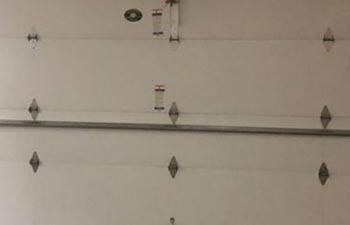
2020 has gotten off to a very wet start here in Georgia. With thunderstorms, flash flood warnings, and days of continuous rain, many people are finding that they are dealing with water inside of places that it should not be. Rainy weather can lead to water leaking into your garage. If you are finding dampness or puddles in your garage, keep reading to learn how to keep water out and to protect your belongings.
The first thing you need to do when you find water in your garage is to determine where the water is coming from. People who have a refrigerator or a deep freezer in their garage may discover that water leakage is coming from one of these appliances. While you may lose food and beverage items from your fridge or freezer, finding this to be the specific problem will save you the hassle of looking elsewhere. However, if your water issue is not caused by an appliance, it will be time to dig a little harder. Water leaking in the garage typically enters from one of three places: the roof, the ground, or from windows. The first thing you need to do is determine the location of the leak by checking corners near your garage and around the windows. Once you know the exact location of the leak, you can take steps to fix it.
If water is leaking in through your windows, it is time to check the caulk around your windows. Any window that is not appropriately sealed will allow moisture to leak into the garage or home. Water simply slides right in around the edges of the window. Fortunately, this is a relatively simple fix. Applying a new layer of caulking around the window should help. It will be beneficial to remove the old layer of caulk first so that a fresh, clean layer of caulking can seal the window appropriately. You will also want to check on the weather stripping on your windows. If the weather stripping is pulling away or is torn, water can easily leak inside. Again, this is an easy fix by simply replacing the old, torn, or missing weather stripping with new material.
Speaking of weather stripping, garage doors should have weather stripping, also referred to as garage seals, that extend the length of the door. When the garage door is closed, the weather stripping should press tightly against the ground to keep water, bugs, and other debris out. Ove time, the weather stripping can weaken. It can rot in places, come unattached, or be damaged. If your garage seal has weakened weather stripping, this may be the culprit for unwanted water inside your garage. The good news is that you can easily replace it with a new rubber floor seal to prevent rainwater from getting inside your garage.
If water pooling in your garage is coming from the roof, you need to check the gutters around the roof. For whatever reason, some homes do not have gutters that run alongside the roof of the garage. Or, they do have gutters, but the downspout extensions are missing. It is imperative that your home has gutters installed along the sides of the roof with downspouts extensions that capture water and direct the water away from the garage door. This will prevent rainwater from soaking under the weather stripping. If the area around your garage is known for standing water, you will want to add a French drain to collect runoff water to keep it away from the house. *It is also important to note that for gutters to work properly, they need to be kept clean and free of debris.
If you find water in your garage and determine that its source is your garage door, don’t panic. Simple steps can be taken to remedy the problem. If you want to be sure that you have waterproofed your garage properly, contact HABPRO Garage Doors. One of our garage door experts can do an inspection to ensure that your garage is well protected from rainwater. And if we do find anything that needs attention, we will be happy to fix it for you.







